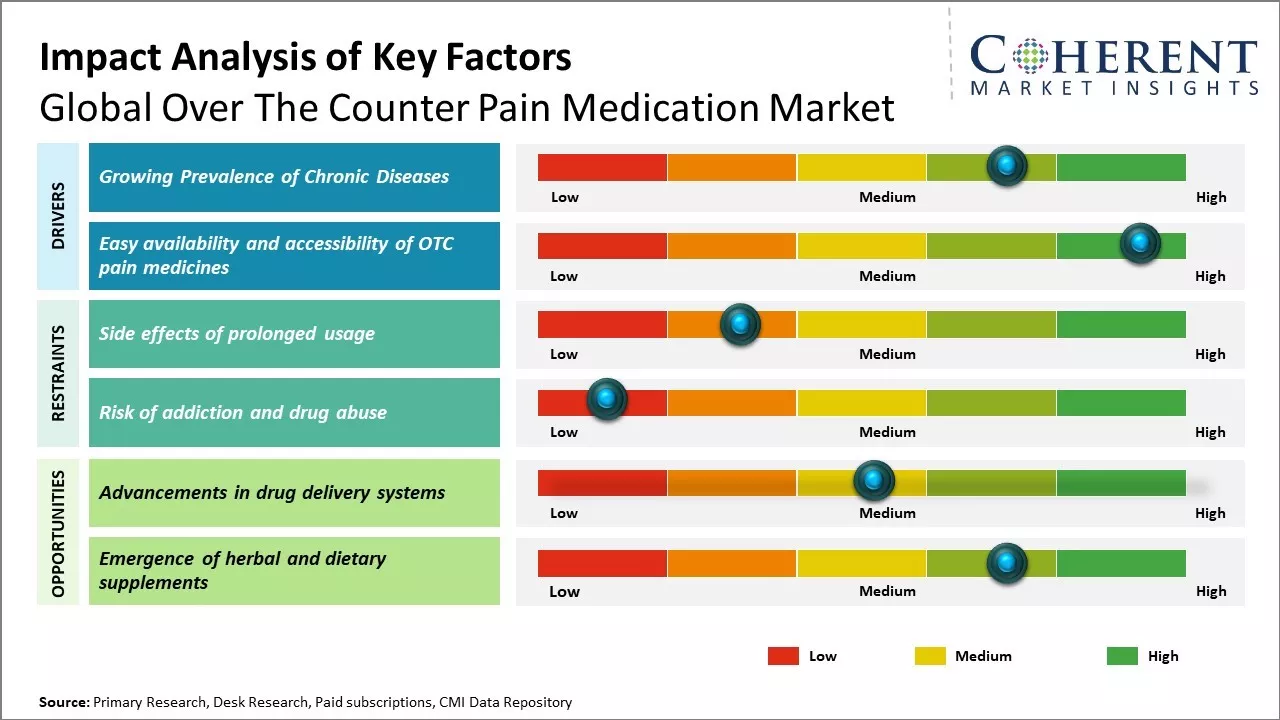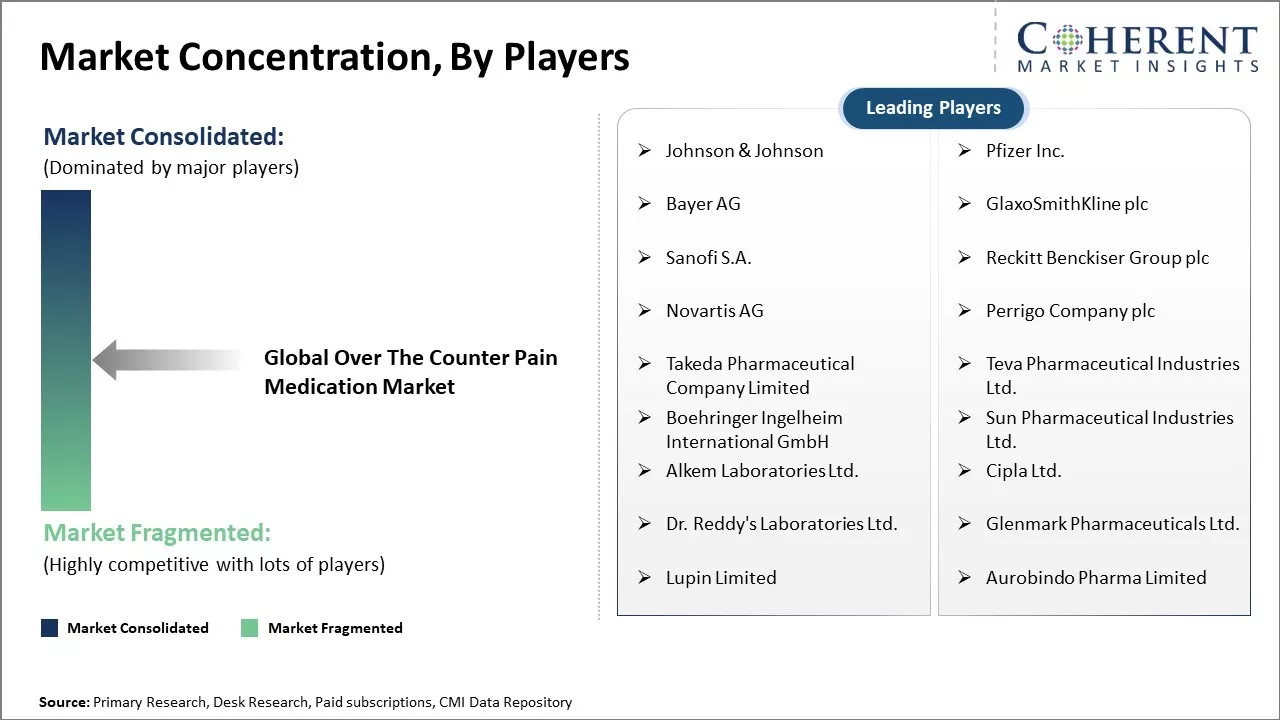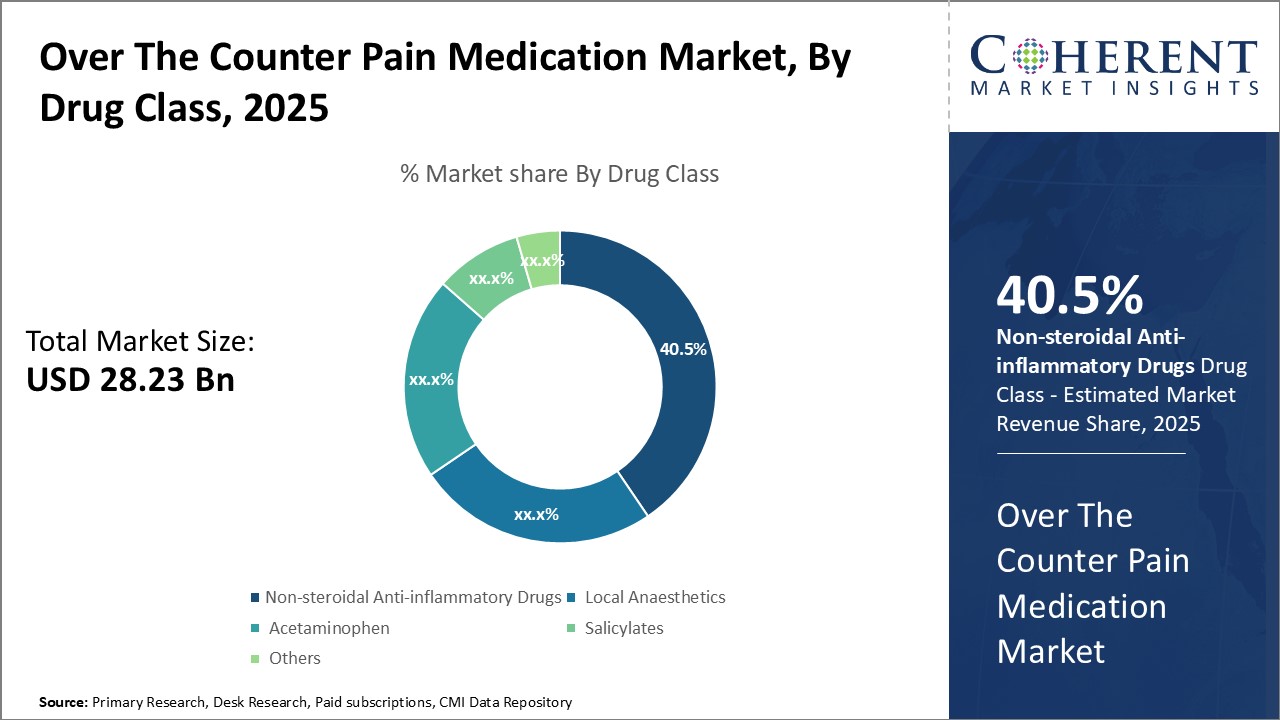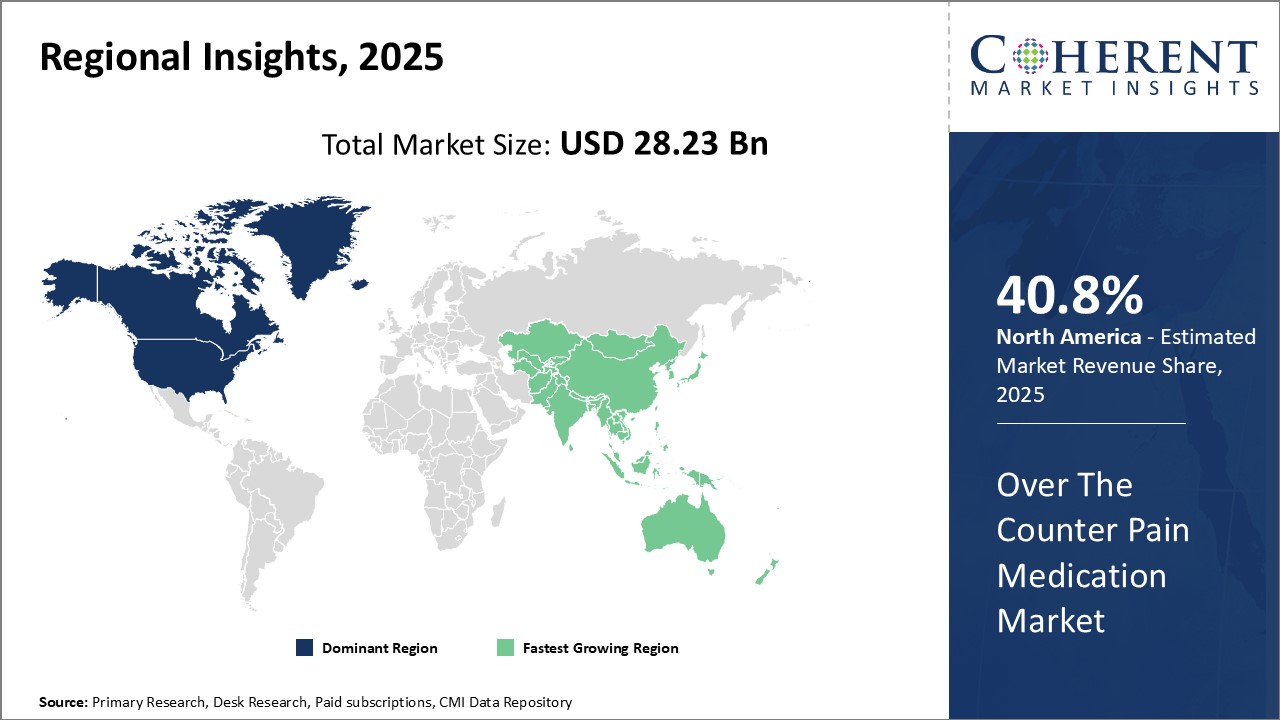Over The Counter Pain Medication Market Size and Trends
The global over the counter pain medication market is estimated to be valued at USD 28.23 Bn in 2025 and is expected to reach USD 37.43 Bn by 2032, exhibiting a compound annual growth rate (CAGR) of 4.1% from 2025 to 2032.

Discover market dynamics shaping the industry: Download Free Sample
The over the-counter pain medication market has been witnessing positive trends over the past few years. The increasing population across the globe along with the rising geriatric population vulnerable to joint pain and arthritis has been a major factor driving the demand for OTC pain medication. In addition, the changing lifestyles and hectic schedules have led to higher stress levels resulting in more back pain, muscle ache, and headaches among people. This has increased the self-medication trend without prescription drugs. Further, advancements in formulations to reduce dosage frequency and increase effectiveness of products have boosted consumer confidence in OTC painkillers. However, the availability of alternative treatment options and growing awareness about side-effects of pain relievers may limit the market growth in the coming years.
Market Driver: Growing Prevalence of Chronic Diseases
The rising prevalence of chronic conditions globally has significantly contributed to the growth of the over-the-counter pain medication market. Chronic diseases requiring long term pain management such as arthritis, back pain, migraines, and headaches have been on a steady rise. It is estimated that nearly 60% of the global population suffer from chronic pain conditions. As people are living longer lives, age-related physical impairments are more commonplace further exacerbating the risks of chronic pain. Busy lifestyles, excessive workload, lack of physical activity, and an aging workforce are also factors fueling the problem. Sufferers of chronic pain often resort to OTC medications for long-term or episodic relief as they are easily available, affordable, and do not require a medical prescription. Pharmacies have witnessed growing demand for popular products containing ibuprofen, acetaminophen, and topical gels/creams. While prescription strength painkillers are also widely used, concerns revolving around addiction, tolerance, and side effects have made OTC drugs an attractive alternative. Physicians too recommend OTC medications as the first line of treatment for mild to moderate pain cases in order to avoid overprescription of opioids or other controlled substances. As chronic conditions become more common worldwide, the use of OTC medications for pain management is likely to increase as well.
Market Concentration and Competitive Landscape

Get actionable strategies to beat competition: Download Free Sample
Easy availability and accessibility of OTC pain medicines
The easy accessibility and availability of over-the-counter pain medications has significantly contributed to the growth of the global over-the-counter pain medication market in recent years. With people increasingly relying on OTC drugs for temporary relief from minor aches and pains, the market has expanded steadily without requiring a prescription. Consumers find OTC drugs more convenient as immediate relief can be self-administered without having to visit a hospital or clinic. This has become especially relevant during the ongoing COVID-19 pandemic. With restrictions on hospital visits and fears of virus spread, more people suffering from pain have turned to easily available analgesic pills and topical pain relievers from drugstores and online pharmacies. The self-care and self-medication trend has further encouraged this shift towards non-prescription pain medication. According to the World Health Organization data, over 60% of the global population prefers to treat minor health issues through self-medication with OTC drugs if the ailments are mild-to-moderate in nature. Additionally, advances in technology have facilitated the growth of this market. E-commerce platforms now allow consumers to order pain medication online without having to step out. This addresses issues of easy access in remote areas. Innovations have also led to newer delivery forms like patches, sprays, and gels that provide pain relief in different ways. All these factors indicate that the OTC pain medication market will continue growing steadily in the coming years on a global scale by improving accessibility and recognizing changing consumer needs and behaviors. However, experts caution about the potential for overuse and dependence issues with prolonged use of certain OTC analgesics without medical supervision. Proper education of consumers will be important to curb misuse and maximize benefits. Regulatory controls may need to be revisited to ensure the safety of widespread non-prescription use, mainly as new technologies support this trend.
Key Takeaways from Analyst:
The global over the counter pain medication market is expected to witness steady growth over the next five years. As lifestyles get busier and stress levels rise due to constant workload, more people are opting for OTC pain relief drugs to get temporary relief from headaches, body aches, and menstrual pains. Self-medication trends will continue to drive sales volumes upward. However, concerns around prolonged usage and side-effects of several OTC drugs may act as a restraint to the market.
North America currently dominates due to growing consumer preference for self-treatment of mild pain conditions. Europe follows suit in terms of uptake of OTC pain meds. Growth in these mature markets is projected to be stable. Meanwhile, Asia Pacific and Latin America will see faster expansion on account of expanding rural healthcare access and rising affordability in populous developing nations.
Pharmaceutical companies need to introduce novel drug delivery mechanisms and herbal formulations to widen the range of options available for different types of pains. This will aid market expansion by catering to a broader customer base. Firms are advised to focus on fast growing Southeast Asian and South American countries through innovative marketing and affordable pricing strategies to gain a strong foothold.
Market Challenges: Side effects of prolonged usage
The prolonged usage of over-the-counter pain medications can lead to several side effects in individuals. Constant intake of medicines containing pain relievers like ibuprofen and acetaminophen over long periods can cause gastrointestinal issues like acidity, ulcers, and intestinal bleeding. Prolonged dependence on such medications for minor aches and pains may damage the kidneys and liver with excessive and regular usage beyond the recommended duration. This can seriously impact the health of consumers in the long run. Such potential health risks associated with side effects are restraining many customers from frequent and continuous reliance on over-the-counter pain relief options. Several studies and reports from international health organizations have highlighted the risks of opioid dependence and addiction with prolonged intake of medications containing codeine and other opioid compounds. For instance, according to the 2021 report from the World Health Organization, nearly 33% of people who were prescribed opioid drugs for chronic non-cancer pain or injury misused them within a year. This led to 2.1 million opioid use disorders globally. The risks of dependence and addiction have made consumers wary of continuously using OTC medications containing codeine, impacting repeat purchases and overall market growth. Awareness of side effects is prompting consumers to seek alternative treatments like physical therapy, acupuncture, or topical creams to manage minor pains. This shift is gradually shrinking the customer base for OTC pain relief products in the long-run, especially if stringent safety checks are not implemented. To sustain growth, companies are investing in R&D to develop safer formulations with reduced risks of side effects and launching public health campaigns to educate proper usage. However, the negative perception around side effects continues to restraint the market.
Market Opportunities: Advancements in drug delivery systems
Advancements in drug delivery systems promise to be a great opportunity for the global over-the-counter pain medication market. Conventional drug delivery methods often experience limitations such as ineffective drug levels at target sites, numerous daily dosages, and lack of patient compliance. The development of novel drug delivery carriers and platforms can help overcome many of these limitations. Controlled and targeted delivery systems allow medications to be released gradually at predetermined rates, maintaining consistent therapeutic drug concentrations at disease sites over an extended period of time. This reduces dosage frequency and improves patient compliance. For example, transdermal drug delivery systems use adhesive patches to deliver pain relieving gels or creams through the skin directly into the bloodstream at a controlled rate for up to 3 days, eliminating the need for multiple daily oral doses. Similarly, polymer-based microsphere and nanoparticle carriers protect drugs from degradation and ensure steady release of encapsulated medications for prolonged pain relief with fewer administrations. Advanced delivery platforms are also working towards improving targeting ability. Stimuli-responsive "smart" drug carriers that are triggered by physical factors like temperature, pH or enzymes present in specific organs can preferentially release higher doses of medication only at sites of pain or inflammation. This enhances therapeutic effects and minimizes adverse reactions. According to a 2021 report by the World Health Organization, targeted drug delivery may help address the global problem of inadequate access to pain treatment, especially in low and middle-income countries.

Discover high revenue pocket segments and roadmap to it: Download Free Sample
By Drug Class- Rising geriatric population drives demand for NSAIDs
In terms of Drug Class, Non-steroidal Anti-inflammatory Drugs (NSAIDs) is estimated to contribute the highest share of the market with 40.5% in 2025 owing to the high prevalence of pain-related conditions among the growing geriatric demographic globally. NSAIDs are commonly used to treat joint pain, muscle pain, backaches, and swollen or injured parts of the body often experienced by older individuals. As life expectancies increase, demographic trends indicate the population aged 65 years and above will surge significantly over the coming decades in both developed and developing nations. Chronic pain is also more prevalent with age. This large and expanding pool of elderly consumers dependent on over-the-counter medications for pain relief has made NSAIDs a staple in many homes and drug cabinets. Their widespread availability without a prescription coupled with proven effectiveness increases their popularity for self-medication of age-related discomforts.
By Route of Administration- Oral administration preferred for convenience
In terms of Route of Administration, Oral segment is estimated to contribute the highest share of the market, with 70.6% in 2025.This is because oral medications are the most practical and convenient self-administration method for over-the-counter drugs, especially for intermittent or occasional pain. Swallowing tablets or capsules allows for pain relief anywhere without the hassle of needing to apply creams or gels. This significant advantage has made oral formulations, such as pills and liquids, the dominant choice for self-treatments. Being easy to use "on-the-go" is important to busy consumers with active lifestyles who may develop headaches or minor muscle strains while out and about. Oral drugs are also more comprehensively studied and tested than topical formulations, giving consumers greater confidence in their safety and effectiveness.
By Dosage Form- Mass appeal of tablets drives demand
In terms of Dosage Form, Tablets/Capsules is estimated to contribute the highest share of the market, with 50.62% in 2024. This can be attributed to tablets being the most universal format palatable to all age groups. Tablets are easily identifiable and there is familiarity with how many to take for dosage instructions. Their solid form also makes tablets highly portable, stable during storage with no risk of leakage, and affordable to produce compared to liquids or creams. The categorical nature of tablets presents a simple and straightforward solution, which aligns with over-the-counter uses where efficacy and ease-of-use are top priorities. Market research also indicates tablets are still the principal preference for occasional self-medication especially among busy working individuals and families.
Regional Insights

Need a Different Region or Segment? Download Free Sample
North America has established itself as a dominant force in the global over-the-counter (OTC) pain medication market with an estimated share of 40.8% in 2025. The large presence of pharmaceutical giants in the U.S. has ensured strong product development and innovation over the years. Access to advanced healthcare infrastructure and higher spending power of consumers in the region have further facilitated widespread adoption of OTC painkillers.
Key players such as Johnson & Johnson, Bayer, and Pfizer have a major presence across both retail pharmacy and e-commerce channels, allowing for easy access to their large pain medication product portfolios. This level of accessibility, coupled with strong brand awareness, has made these companies' products top choices for pain relief. As ongoing R&D activities continuously yield novel formulations, North America also enjoys early availability of the latest product advances.
The Asia Pacific region has emerged as the fastest growing regional market for OTC pain medications globally. This can be attributed to rising income levels and growth of urban middle-class populations across countries like China, India, and Indonesia. Greater affordability of healthcare resources and increasing self-medication trends have also boosted market penetration. While regulatory frameworks differ from country to country, Asia Pacific offers conducive conditions for both local and multinational companies. Many international brands strategically partner with local distributors to optimize sales reach within the region. Furthermore, weaker price controls in Asia Pacific have allowed flexibility in pricing strategies to improve affordability. This has encouraged consumers to transition from traditional alternatives to scientifically formulated branded medications. Overall, this region presents an immense untapped potential that companies are actively exploring.
Market Report Scope
Over The Counter Pain Medication Market Report Coverage
| Report Coverage | Details | ||
|---|---|---|---|
| Base Year: | 2024 | Market Size in 2025: | USD 28.23 Bn |
| Historical Data for: | 2020 To 2024 | Forecast Period: | 2025 To 2032 |
| Forecast Period 2025 to 2032 CAGR: | 4.1% | 2032 Value Projection: | USD 37.43 Bn |
| Geographies covered: |
|
||
| Segments covered: |
|
||
| Companies covered: |
Johnson & Johnson, Pfizer Inc., Bayer AG, GlaxoSmithKline plc, Sanofi S.A., Reckitt Benckiser Group plc, Novartis AG, Perrigo Company plc, Takeda Pharmaceutical Company Limited, Teva Pharmaceutical Industries Ltd., Boehringer Ingelheim International GmbH, Sun Pharmaceutical Industries Ltd., Alkem Laboratories Ltd., Cipla Ltd., Dr. Reddy's Laboratories Ltd., Glenmark Pharmaceuticals Ltd., Lupin Limited, Aurobindo Pharma Limited |
||
| Growth Drivers: |
|
||
| Restraints & Challenges: |
|
||
Uncover macros and micros vetted on 75+ parameters: Get instant access to report
Over The Counter Pain Medication Industry News
- In March 2024, The U.S. FDA has warned against using certain over-the-counter topical analgesics for pain relief before, during, or after cosmetic procedures like microdermabrasion, laser hair removal, tattooing, and piercing. The agency sent warning letters to six companies for illegal marketing of these products.
- In October 2023, the USFDA approval for the powerful non-opioid painkiller Maxigesic IV was announced by Belgium-based Hyloris Pharmaceuticals. Maxigesic IV is intended to be used as an adjuvant for moderate-to-severe pain and for mild-to-moderate pain, having been developed in collaboration with AFT Pharmaceuticals. An option to narcotic medications is provided by this postoperative infusion, which contains 1,000 mg of paracetamol and 300 mg of ibuprofen.
- In August 2022, Myovant Sciences, a biopharmaceutical company, and Pfizer announced that the USFDA had approved MYFEMBREE (relugolix, estradiol, and norethindrone acetate) as a once-daily pill for managing moderate to severe endometriosis pain in pre-menopausal women, with a treatment duration of up to 24 months. The approval, supported by data from Phase 3 trials and an open-label extension study, also includes treatment for heavy menstrual bleeding due to uterine fibroids.
- In June 2021, Bayer, a pharmaceutical company, announced that the U.S. Food and Drug Administration (FDA) approved Astepro Allergy as an over-the-counter (OTC) product. It provides temporary relief from nasal congestion, runny nose, itchy nose, and other respiratory allergies.
- In March 2020, GSK received FDA approval for Advil Dual Action with Acetaminophen as an over-the-counter (OTC) product for pain relief. This marks the first FDA-approved OTC combination of ibuprofen and acetaminophen in the U.S., and it will be available globally.
*Definition: The Global Over The Counter Pain Medication Market refers to the consumer healthcare market for non-prescription pain relief medications that are sold directly to consumers without requiring a prescription from a healthcare professional. This includes popular over-the-counter medications like acetaminophen, ibuprofen, naproxen, and aspirin that are commonly used to relieve headache, muscle ache, arthritis pain, back pain, toothache, menstrual cramps, colds, and fever on an as-needed basis.
Market Segmentation
- Drug Class Insights (Revenue, USD Bn, 2020 - 2032)
- Non-steroidal Anti-inflammatory Drugs (NSAIDs)
- Local Anaesthetics
- Acetaminophen
- Salicylates
- Others
- Route Of Administration Insights (Revenue, USD Bn, 2020 - 2032)
- Oral
- Topical
- Others
- Dosage Form Insights (Revenue, USD Bn, 2020 - 2032)
- Tablets/Capsules
- Liquids
- Creams
- Gels
- Others
- Distribution Channel Insights (Revenue, USD Bn, 2020 - 2032)
- Hospital Pharmacies
- Retail Pharmacies
- Online Pharmacies
- Regional Insights (Revenue, USD Bn, 2020 - 2032)
- North America
- U.S.
- Canada
- Latin America
- Brazil
- Argentina
- Mexico
- Rest of Latin America
- Europe
- Germany
- U.K.
- Spain
- France
- Italy
- Russia
- Rest of Europe
- Asia Pacific
- China
- India
- Japan
- Australia
- South Korea
- ASEAN
- Rest of Asia Pacific
- Middle East
- GCC Countries
- Israel
- Rest of Middle East
- Africa
- South Africa
- North Africa
- Central Africa
- North America
- Key Players Insights
- Johnson & Johnson
- Pfizer Inc.
- Bayer AG
- GlaxoSmithKline plc
- Sanofi S.A.
- Reckitt Benckiser Group plc
- Novartis AG
- Perrigo Company plc
- Takeda Pharmaceutical Company Limited
- Teva Pharmaceutical Industries Ltd.
- Boehringer Ingelheim International GmbH
- Sun Pharmaceutical Industries Ltd.
- Alkem Laboratories Ltd.
- Cipla Ltd.
- Dr. Reddy's Laboratories Ltd.
- Glenmark Pharmaceuticals Ltd.
- Lupin Limited
- Aurobindo Pharma Limited
Share
Share
About Author
Vipul Patil is a dynamic management consultant with 6 years of dedicated experience in the pharmaceutical industry. Known for his analytical acumen and strategic insight, Vipul has successfully partnered with pharmaceutical companies to enhance operational efficiency, cross broader expansion, and navigate the complexities of distribution in markets with high revenue potential.
Missing comfort of reading report in your local language? Find your preferred language :
Transform your Strategy with Exclusive Trending Reports :
Frequently Asked Questions
EXISTING CLIENTELE
Joining thousands of companies around the world committed to making the Excellent Business Solutions.
View All Our Clients
